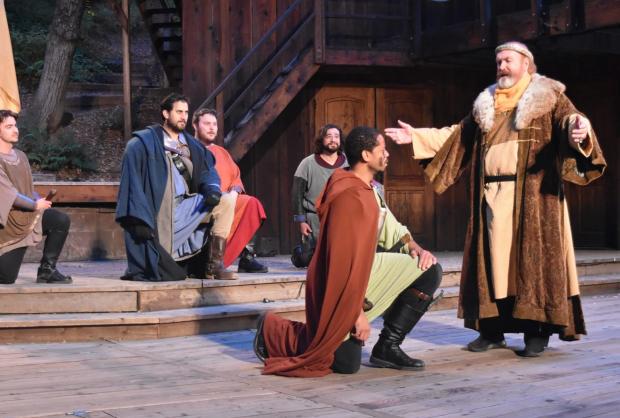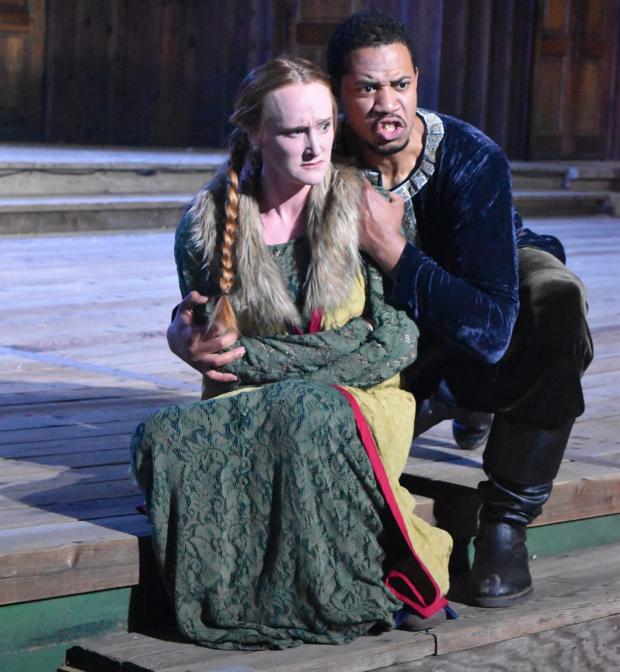Advertisement
Will Geer’s Theatricum Botanicum’s rendition of William Shakespeare’s immortal masterpiece Macbeth is a bone-chilling excursion into ambition unbound, bloodlust and madness. As the title character (portrayed by the estimable Max Lawrence) quite literally slashes his way to the top of the heap in 11th century Scotland to seize and keep the crown, the astute theatergoer can’t help but reflect on power struggles in today’s America as our quadrennial presidential contest unfolds.
After a military victory, Macbeth and his friend Banquo, one of King Duncan’s generals, encounter four witches on a heath who plant the seed that the protagonist is, as Rudyard Kipling would later put it, the man who would be king. Enter Ross (Steven C. Fisher), who informs Macbeth that a grateful Duncan, King of Scotland (Franc Ross in a double role; he also plays Porter), has promoted him to the rank of Thane of Cawdor. (A thane is a Scottish title for a nobleman who owns land in exchange for military service to the throne.) This promotion confirms the first prophecy of the witches, who are rather splendidly, spectrally played by Claire Simba (who likewise excels as Joan of Arc in WGTB’s Queen Margaret’s Version of Shakespeare’s War of the Roses and has an assistant director credit for Macbeth), Sara Carpenter, Christopher Glenn Gilstrap and Sky Wahl. (Let’s hope that these hauntingly memorable thesps are remembered when the Ovation and other awards for L.A. theater are bestowed upon deserving talents.)
To this reviewer, the scene-stealing, preternaturally creepy witches, who reappear in Act II, are played like a cross between the inmates at Charenton asylum in Peter Weiss’ Marat/Sade and the terrifying Manson tribe. They are so uncannily eerie that it seems they cast a spell on Macbeth that compels him to slaughter his way to the throne. In this endeavor, Macbeth is egged on by his crafty wife, Lady Macbeth (the enthralling Willow Geer), an unrelentingly power-hungry character who pushes her husband on to commit his brazen, bloody deeds. The unladylike Lady Macbeth uses her sexuality to manipulate her insecure husband – a picture of Macbeth could be next to “pussy-whipped” in the Merriam Webster dictionary. Willow has both the talent and beauty to convincingly pull off this monomaniacal role – for her husband, Lady M (as in “murder”) is to kill, and eventually, to die for.
While murderous ambition is the theme of Macbeth, for me, the most interesting thing about this play first produced circa 1606 is how the Elizabethan era playwright presages psychoanalysis almost three centuries before the invention of psychology as a science. In Act V, Scene III (of the original), when the Doctor (Andy Stokan) informs the king about his wife’s insomnia, Macbeth beseeches: “Cure her of that.
Canst thou not minister to a mind diseased,
Pluck from the memory a rooted sorrow,
Raze out the written troubles of the brain
And with some sweet oblivious antidote
Cleanse the stuff'd bosom of that perilous stuff
Which weighs upon the heart?”
In addition to Lady Macbeth’s sleepwalking, her husband, too, suffers manic outbursts, including during a feast inside his castle at Inverness, where he imagines seeing the quite dead bloodied Banquo (Jeff Wiesen), whom Macbeth had solicited the homicide of. The Thane of Cawdor is truly an insane thane, driven to madness by hubristic, greedy ambition. So, in addition to being a tragedy about viciously fierce faction fights, Macbeth is a case study in mental illness. (Paging Dr. Freud!)
(Parenthetically, it’s interesting to note, that like Lady Macbeth, the obviously psychopathic Trump, who once again is a pretender to the throne (Note to self: Renew passport), suffers from insomnia. During sleep, the superego cedes and even loses control over the functions of the mind, which in the form of dreams unleashes coded messages about the crimes one has committed. One way to avoid this psychic accountability is simply not to fall asleep for as long as possible.)
Ellen Geer, WGTB’s Producing Artistic Director, adeptly helms this production, which I assume she has edited down – with one intermission, what originally was a five-act play as written by the Bard of Stratford-upon-Avon, clocked in at about two and a half hours long under Geer’s guidance. It may be set in the Scottish Highlands, but this version of Macbeth is staged in hilly Topanga Canyon, and to great effect. The cast makes excellent use of the space, on and off the boards, with actors up and down the aisles, in the surrounding natural environs, enhancing an immersive experience of “sacrilegious murder,” as Macduff (a superb Aaron Hendry) put it.
Consumed by righteous rage, upon learning that his family has been executed by Macbeth, Macduff turns into a Maccabean warrior. The onstage swordplay between Macbeth and Macduff – up close and personal right in front of the audience’s eyes in for real 3D – is arguably more exciting than all the filmic special effects in Oppenheimer, such is the thrill of live action, the provenance of the theatrical experience. This deadly duel may bring to mind Errol Flynn and Basil Rathbone’s thrust and parry (minus the massive shadows and Erich Wolfgang Korngold’s score!) in that 1938 Hollywood classic, The Adventures of Robin Hood, helmed by Michael Curtiz. Kudos not only to those Musketeers Hendry and Lawrence of Topanga, but fight choreographer Cavin Mohrhardt (who also choreo-ed the en masse mise-en-scène onstage battles in Queen Margaret’s Version of Shakespeare’s War of the Roses).
Now, in case, the reader hasn’t gotten this point yet, Macbeth is an exceedingly violent show, complete not only with swordsmanship, but beheadings, the murder of children, lots of blood spilled, stabbings, slicing, dicing, etc. When Lady Macbeth utters: “Out, out damn spot!” it is not a reference to Dick and Jane trying to see their dog Spot run. In other words, this production is arguably not for children; leave the kiddies (and excessively sensitive grownups) at home.
But serious adult theatergoers are likely to be enthralled by what is probably one of the five most profound plays by the Bard, who put quill to parchment to create about 40 works for the live stage. Oft-produced over the past 400-years-plus, there have been a number of nobly notable adaptations. They include Akira Kurosawa’s Throne of Blood, a 1957 Japanese film starring that über-samurai, Toshiro Mifune, swordsman par excellence. Barbara Garson’s 1966 political satire MacBird! reframed President John F. Kennedy’s (aka “John Ken O’Dunc”) assassination into the contours of Macbeth. When I was a kid, for some reason my theatergoing parents “dragged” me to see MacBird! at Manhattan’s the Village Gate, and I never forgot this dialogue (FYI, MacBird = LBJ, played by Stacey Keach, and Crony = presidential aide):
“CRONY: Peace paraders marching.
MACBIRD: Stop ’em!
CRONY: Beatniks burning draft cards.
MACBIRD: Jail ’em!
CRONY: Negroes starting sit-ins.
MACBIRD: Gas ’em!
CRONY: Latin rebels rising.
154 MACBIRD: Shoot ’em!
CRONY: Asian peasants arming.
MACBIRD: Bomb ’em!
CRONY: Congressmen complaining.
MACBIRD: Fuck ’em!”
But the famous iteration of Shakespeare’s tragedy which WGTB’s Macbeth most put me in mind of is Orson Welles’ renowned 1936 Voodoo Macbeth. This all-Black version, with voodoo priests replacing the witches, was a production of the Negro Theatre Unit for the Federal Theatre Project, which was part of the New Deal’s WPA programs, and the closest thing America has had to a truly national theater. Voodoo Macbeth’s cast of 150 included only four professional actors, with Jack Carter portraying Macbeth and Canada Lee as Banquo. In 2022 an indie movie dramatized the creation of Voodoo Macbeth, co-starring Inger Tudor as the Negro Theatre Unit’s co-director Rose McClendon and Jewell Wilson Bridges as Welles.
The reason why the rendition currently on the boards at Topanga Canyon reminds me of Voodoo Macbeth is, as in the Welles/McClendon presentation, because of the prominence of Black performers in the traditionally Caucasoid realm of Shakespearean works (with exceptions, notably Othello). Claire Simba opens the show as a wailing witch (and those witches are reminiscent of Welles’ Voodoo priests); she also plays a Lady Macduff who doesn’t take any guff. Of course, the title character is depicted by Max Lawrence, a WGBT stalwart with many creditable performances under his gifted belt, notably in the Theatricum’s Trouble in Mind and Animal Farm, as the Stakhanovite horse Boxer, as well as playing York this summer in Queen Margaret’s Version of Shakespeare’s War of the Roses. Here, Lawrence delivers a rip-roaring performance as the scheming Macbeth, who dunks Duncan and goes for broke – and for Banquo, plus anyone else who dares stand in his overly ambitious way. Non-traditional casting has long been a mainstay at this Topanga outpost of progressivism, spawned by the Hollywood Blacklist.
WGTB’s current reprising of Shakespeare’s classic is a worthy addition to the long line of Macbeth’s theatrical/literary legacy. Almost 1,000 years after Macbeth takes place and 400-plus years after the curtain first lifted on it, presumably at London’s the Globe Theatre, the themes of this Shakespearean tragedy still, alas!, ring all too true. In my opinion, this gripping drama with stellar performances and direction are well worth the sojourn out to resplendent Topanga Canyon, and WGTB’s best offering during this summer’s season.
Will Geer’s Theatricum Botanicum is presenting Macbeth through September 23 in repertory with, Queen Margaret’s Version of Shakespeare’s War of the Roses, A Midsummer Night’s Dream and A Perfect Ganesh at 1419 North Topanga Canyon Blvd., Topanga, California 90290. For info and tickets: 310-455-3723; https://theatricum.com/queen-margarets-version-of-shakespeares-war-of-the-roses-2/.




